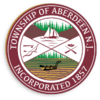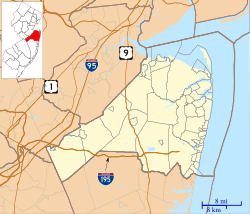Aberdeen Township, New Jersey facts for kids
Quick facts for kids
Aberdeen Township, New Jersey
|
||
|---|---|---|
|
Township
|
||

Mouth of Matawan Creek at the border of Keyport borough and Aberdeen Township
|
||
|
||
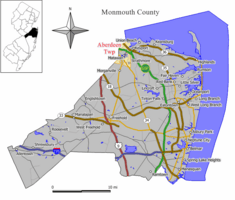
Location of Aberdeen Township in Monmouth County highlighted in yellow (right). Inset map: Location of Monmouth County in New Jersey highlighted in black (left).
|
||
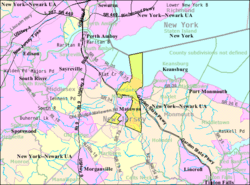
Census Bureau map of Aberdeen Township, New Jersey
|
||
| Country | ||
| State | ||
| County | Monmouth | |
| Incorporated | February 23, 1857, as Matavan Township | |
| Renamed | 1882 as Matawan Township | |
| Renamed | November 8, 1977, as Aberdeen Township | |
| Government | ||
| • Type | Faulkner Act (council–manager) | |
| • Body | Township Council | |
| Area | ||
| • Total | 7.77 sq mi (20.13 km2) | |
| • Land | 5.45 sq mi (14.10 km2) | |
| • Water | 2.33 sq mi (6.03 km2) 29.95% | |
| Area rank | 234th of 565 in state 15th of 53 in county |
|
| Elevation | 13 ft (4 m) | |
| Population
(2020)
|
||
| • Total | 19,329 | |
| • Estimate
(2023)
|
19,230 | |
| • Rank | 143rd of 565 in state 11th of 53 in county |
|
| • Density | 3,550.2/sq mi (1,370.7/km2) | |
| • Density rank | 189th of 565 in state 20th of 53 in county |
|
| Time zone | UTC−05:00 (Eastern (EST)) | |
| • Summer (DST) | UTC−04:00 (Eastern (EDT)) | |
| ZIP Code | ||
| Area codes | 732 | |
| FIPS code | 3402500070 | |
| GNIS feature ID | 0882121 | |
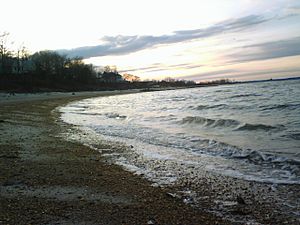
Aberdeen Township is a community located on the Jersey Shore in Monmouth County, New Jersey. It's part of the larger New York Metropolitan Area. The township borders Old Bridge Township, New Jersey and even Staten Island in New York City.
As of the 2020 United States census, Aberdeen Township had a population of 19,329 people. This was the highest number of residents ever recorded for the township.
Aberdeen Township was once part of the Bayshore Regional Strategic Plan. This plan aimed to improve the economy of northern Monmouth County. It focused on traditional downtown areas, neighborhoods, maritime history, and the natural environment. Aberdeen has also worked with nearby Matawan to develop areas around the Aberdeen-Matawan train station.
Contents
History of Aberdeen Township
Early Settlements
The first people to live in this area were the Lenni Lenape Native Americans. Around the year 1000, they developed farming communities. They began to move west as European settlers arrived and diseases spread. Even though the Lenape now live in other places, their names live on in local places like Matawan Creek.
The first known European attempt to settle here was in 1650. The New Netherland Colony bought the land on the south side of Raritan Bay from the Lenni Lenape.
How New Aberdeen Got Its Name
The earliest English land grant in this area was in 1677. Sir George Carteret gave 36 acres (about 14.5 hectares) to Jonathan Holmes. This area is now called Oakshades.
Matawan Township changed its name to Aberdeen Township in 1977. This new name honored the Scottish settlers who called this part of Monmouth County "New Aberdeen" in the 1680s. These settlers were Quakers and Presbyterians who came from Scotland to escape religious persecution.
In the 1680s, many Scottish immigrants arrived. They were encouraged by a book written in 1683 by George Scott. He wrote about how great it was to settle in East Jersey. In 1701, a village site of 100 acres (about 40 hectares) was given to 24 Scottish settlers. They also bought a landing spot on Matawan Creek. This village became known as Mount Pleasant. The landing became an important shipping point and was called Middletown Point.
From Middletown to Matawan
In 1693, what is now Aberdeen Township became part of a much larger area called Middletown Township. This huge area included many current towns like Holmdel, Hazlet, and Keyport.
Middletown Township was considered too big. So, in February 1848, the western half was separated to create a new town called Raritan Township. This is now Hazlet Township.
On February 23, 1857, Matavan Township was officially created. It was formed from parts of Raritan Township. The name "Matavan" came from the creek and a local village. The spelling "Matawan" or "Matavan" was used interchangeably. The name might come from a Lenape word meaning "where two rivers come together."
In 1865, the Middletown Point post office was renamed "Matawan" to match the township's name. This area is now downtown Matawan Borough. In 1882, the township's spelling was officially changed to "Matawan."
A small train station was built in 1875 at a place called Hutchler's Crossing. It became known as the Cliffwood Station. It operated until 1932.
In 1885, the Cliffwood post office was opened. The old name "Matavan" slowly disappeared. Matawan became its own borough on June 28, 1895.
A post office was opened in Mount Pleasant in 1889. Since that name was already used elsewhere, it was renamed "Freneau." This was to honor Philip Morin Freneau, a famous poet who lived there. This post office is now closed.
Cliffwood Beach started as a resort community in the 1920s. After World War II, it became a place for year-round homes. The Strathmore community was built in the early 1960s. This development added 2,000 new homes, causing the township's population to grow by over 140%.
Aberdeen Township Today
On November 8, 1977, residents of Matawan Township voted to change the name to Aberdeen Township. They wanted a unique identity separate from Matawan Borough. Officials thought the new name would help the township stand out.
Today, Aberdeen is a suburban township. It has homes, light industries, and shopping centers. Some of its sections include Cliffwood, Cliffwood Beach, Freneau, and Strathmore. Three different ZIP Codes serve the township: 07721, 07735, and 07747.
The township has two volunteer fire companies and two volunteer First Aid Squads. A full-time Police Department was started in 1935.
The Henry Hudson Trail is a 9-mile (14 km) paved path. It was built on an old railroad track. You can walk or bike on it from Aberdeen Township to Atlantic Highlands.
Geography and Location
Aberdeen Township covers about 7.77 square miles (20.13 square kilometers). About 5.45 square miles (14.10 square kilometers) is land, and 2.33 square miles (6.03 square kilometers) is water.
The township has two parts that are not connected. A small wedge-shaped area in the southwest is separated by a part of Matawan.
Cliffwood Beach and Strathmore are communities within Aberdeen Township. Other communities include Cliffwood.
Aberdeen Township shares borders with several other towns in Monmouth County. These include Hazlet Township, Holmdel Township, and Matawan. It also borders Old Bridge Township in Middlesex County. The township also has a water border with Staten Island in New York City.
Population Information
| Historical population | |||
|---|---|---|---|
| Census | Pop. | %± | |
| 1860 | 2,072 | — | |
| 1870 | 2,839 | 37.0% | |
| 1880 | 2,699 | −4.9% | |
| 1890 | 1,092 | −59.5% | |
| 1900 | 1,310 | 20.0% | |
| 1910 | 1,472 | 12.4% | |
| 1920 | 1,856 | 26.1% | |
| 1930 | 2,496 | 34.5% | |
| 1940 | 2,633 | 5.5% | |
| 1950 | 3,888 | 47.7% | |
| 1960 | 7,359 | 89.3% | |
| 1970 | 17,680 | 140.3% | |
| 1980 | 17,235 | −2.5% | |
| 1990 | 17,038 | −1.1% | |
| 2000 | 17,454 | 2.4% | |
| 2010 | 18,210 | 4.3% | |
| 2020 | 19,329 | 6.1% | |
| 2023 (est.) | 19,230 | 5.6% | |
| Population sources: 1860–1920 1860–1870 1870 1880–1890 1890–1910 1910–1930 1940–2000 2000 2010 2020 |
|||
In 2020, Aberdeen Township had a population of 19,329 people. This was an increase from 18,210 people in 2010. The population density was about 3,550 people per square mile.
The township is home to a diverse group of people. In 2010, about 76.6% of residents were White, 11.9% were Black or African American, and 6.4% were Asian. About 10.4% of the population was Hispanic or Latino.
The median age in 2010 was 39.0 years old. About 23.1% of the population was under 18. The average household had 2.64 people.
How Aberdeen Township is Governed
Local Government
Aberdeen Township uses a "Council-Manager" form of government. This means a Township Council makes the main decisions. The Mayor is part of the council and leads its meetings. A Manager is hired by the council to handle the daily operations of the township.
The Township Council has seven members. They are elected for four-year terms. The Mayor is directly elected. The council members choose one of themselves to be the Deputy Mayor.
As of 2024, the Mayor of Aberdeen Township is Fred Tagliarini. His term ends on December 31, 2025.
State and County Representation
Aberdeen Township is part of New Jersey's 6th Congressional district. It is also in the 13th state legislative district.
New Jersey's Sixth Congressional District is represented by Frank Pallone (D, Long Branch). New Jersey is represented in the United States Senate by Cory Booker (D, Newark, term ends 2021) and Bob Menendez (D, Paramus, 2019). For the 2016–2017 session (Senate, General Assembly), the 13th Legislative District of the New Jersey Legislature is represented in the State Senate by Joseph M. Kyrillos (R, Middletown Township) and in the General Assembly by Amy Handlin (R, Middletown Township) and Declan O'Scanlon (R, Little Silver). Monmouth County is governed by a Board of County Commissioners composed of five members who are elected at-large to serve three-year terms of office on a staggered basis, with either one or two seats up for election each year as part of the November general election. At an annual reorganization meeting held in the beginning of January, the board selects one of its members to serve as director and another as deputy director. As of 2024[update], Monmouth County's Commissioners are:
Director Thomas A. Arnone (R, Neptune City, 2025), Susan M. Kiley (R, Hazlet Township, 2024), Erik Anderson (R, Shrewsbury, 2026), Nick DiRocco (R, Wall Township, 2025), and Deputy Director Ross F. Licitra (R, Marlboro Township, 2026).
Constitutional officers elected on a countywide basis are: Clerk Christine Giordano Hanlon (R, 2025; Ocean Township), Sheriff Shaun Golden (R, 2025; Howell Township) and Surrogate Rosemarie D. Peters (R, 2026; Middletown Township).
Politics
| Year | Republican | Democratic | Third party | |||
|---|---|---|---|---|---|---|
| No. | % | No. | % | No. | % | |
| 2024 | 5,600 | 51.51% | 5,087 | 46.79% | 185 | 1.70% |
| 2020 | 5,021 | 44.99% | 5,989 | 53.66% | 150 | 1.34% |
| 2016 | 4,126 | 47.22% | 4,328 | 49.53% | 284 | 3.25% |
| 2012 | 3,054 | 42.14% | 4,109 | 56.69% | 85 | 1.17% |
| 2008 | 3,817 | 44.70% | 4,635 | 54.27% | 88 | 1.03% |
| 2004 | 3,644 | 46.62% | 4,105 | 52.52% | 67 | 0.86% |
| 2000 | 2,559 | 35.95% | 4,262 | 59.88% | 297 | 4.17% |
| 1996 | 2,136 | 31.97% | 3,912 | 58.55% | 634 | 9.49% |
| 1992 | 2,857 | 38.94% | 3,352 | 45.69% | 1,128 | 15.37% |
As of March 2011, there were over 11,000 registered voters in Aberdeen Township. Most voters were registered as Unaffiliated, meaning they don't belong to a specific political party.
In the 2024 presidential election, the Republican candidate won in Aberdeen Township. This was the first time a Republican candidate had won the township since at least 1992.
Schools and Learning
Aberdeen Township is part of the Matawan-Aberdeen Regional School District. This district also includes the nearby community of Matawan. The district has seven schools.
- Cambridge Park Elementary School (PreK–K)
- Cliffwood Elementary School (PreK–3)
- Ravine Drive Elementary School (PreK–3)
- Strathmore Elementary School (PreK–3)
- Lloyd Road Elementary School (grades 4–5)
- Matawan Aberdeen Middle School (grades 6–8)
- Matawan Regional High School (grades 9–12)
In the 2022–23 school year, the district had about 3,950 students. There were about 352 teachers, meaning there were about 11 students for every teacher. The school board has nine members, with six of them representing Aberdeen Township.
The Yeshiva Gedolah of Cliffwood is also located in the township. It is a higher education institution.
Getting Around
Roads and Highways
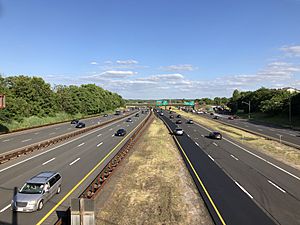
As of 2010, Aberdeen Township had over 65 miles (105 km) of roads. Most of these roads are maintained by the township itself.
The Garden State Parkway is the biggest highway in Aberdeen. Route 34 and Route 35 also pass through the township.
Public Transportation
NJ Transit provides bus services from Aberdeen Township to Midtown Manhattan in New York City. These buses include the 133 and 135 routes. The 817 route also connects Aberdeen to other nearby towns.
The Aberdeen-Matawan station is a train station located in Aberdeen. It's on the NJ Transit North Jersey Coast Line. You can take a train north to New York Penn Station or south to Bay Head station.
Famous People from Aberdeen Township
Many notable people have lived in or are connected to Aberdeen Township:
- Jay Bellamy (born 1972), a former NFL safety for the Seattle Seahawks and New Orleans Saints.
- Anthony Brown (born 1998), an American football quarterback for the Las Vegas Raiders.
- Erison Hurtault (born 1984), a sprinter who has competed for Dominica in international events.
- Jodi Lyn O'Keefe (born 1978), an actress and model.
- Retta (born 1970), a comedian and actress known for her roles in Parks and Recreation and Good Girls.
- Charlie Rogers (born 1976), a former NFL running back and wide receiver.
- David L. Smith, known for creating the Melissa computer virus.
- Eileen Tell (born 1966), a former professional tennis player.
See also
 In Spanish: Municipio de Aberdeen (Nueva Jersey) para niños
In Spanish: Municipio de Aberdeen (Nueva Jersey) para niños


